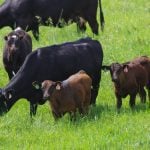
Nikki Olson farms with her husband, Tyler, and his family, just outside of Red Deer, Alta. She grew up on a mixed farm near Calgary and was an avid 4-H member for 10 years where she found success with public speaking, various beef projects, along with cooking and photography. While attending Olds College, she served on multiple school boards and represented the Aggies Club as president and vice-president. Two years after graduating, she started her own agronomy company. She also took on a bigger role at the farm, and now manages the Shorthorn-Angus herd she and her husband share with her in-laws. Olson is an active member of the Agri-Trade Advisory Committee. Her mentor is Kelly Smith-Fraser of NuHaven Cattle Co. at Pine Lake, Alta. In 2019, Smith-Fraser became the first female chair of the Alberta Beef Producers and was appointed board chair of AFSC in 2021.

Rheanne Ritchie hails from a small hobby farm at Olds, Alta. She completed a bachelor’s and a master’s degree at the University of Calgary in zoology, and environmental sciences, respectively. Shortly thereafter, she met her husband and settled in Didsbury, Alta., where they are now part of a third-generation, centennial family farm. After finishing her initial degrees, she enrolled in vet school at the University of Calgary. Ritchie hopes to work as a vet within the community, while also expanding her family’s Angus herd and the farm operation. Ritchie’s mentor is Dr. Egan Brockhoff, a farmer and practicing swine vet. Brockhoff chairs the Canadian African Swine Fever Compartmentalization Working Group and the National Biosecurity Standard Working Group.
Read Also

Scholarship winners, board elections and more beef industry news
Scholarship winners, board elections, Canadian Cattle Young Leader bios, and provincial Environmental Stewardship Award winners
Congratulations to all the provincial winners of the 2022 Environmental Stewardship Award (TESA), as well as to the national winner. Representing the Maritimes are Alanda, Cedric and Kalen MacLeod of Local Valley Beef, located in Carleton County, New Brunswick. This first-generation farm has restored pasture through intensive rotational grazing and by introducing white clover, alfalfa and several grasses to the pasture. They also swap land with potato growers.
In southwestern Quebec, Stéphane Guay runs Ferme Guayclair with a regenerative focus. Four years ago, Guay switched from dairy to beef production and started grazing his cropland. He also grows fruit trees both for food production and as a wind break, and seeds cover crops into his cash crops, in a bid to boost the soil biology.
The Grey-Dufferin Community Pasture in Ontario focuses on managing water and rotational grazing. The pasture also forgoes commercial fertilizers in favour of municipal compost, which pasture spokesman Mike Swidersky told The Western Producer is good for grass production, the environment and the community. The pasture has grown from 150 cattle to over 600 head, on 700 acres.
Patti and Gerald Anhorn operate Windy Ridge Ranching Co. near Elrose, Sask. When they bought the ranch 22 years ago, most of it was native grass, and they prioritized protecting that grass through an aggressive rotational grazing strategy and plenty of rest time. The Anhorns also seeded marginal farmland to perennial covers, allowing them to hold off grazing the native grass until later in the year.
In Alberta, Jerry and Dawn Baerg and family run Ribbon Creek Ranch near Linden. The Baergs built a fencing system allowing them to rotate cattle through native grass pastures so as to protect the fragile land. They also place water troughs strategically in lesser-grazed areas, plant perennial grass into some of their cropland, grow polycrops and have annual grazing crops in the rotation.

Finally, B.C.’s Fossen family are the national TESA winners. Doug and Erika Fossen — along with daughters Adele, Reine and Jade — operate Bar 7 Ranch at Rock Creek. Their rotational grazing strategy is geared to avoid overgrazing by giving plants time to recover. They usually plan to graze only once per year, but they may graze a second time, depending on the year. Riparian areas are either fenced, with a trough for cattle to drink, or grazed late in the year, once the ground is frozen.
Garner Deobald of Hodgeville, Sask., is the new president of the Saskatchewan Stock Growers Association, while Kelcy Elford of Caron moved into the past president seat. Rounding out the executive are Jeff Yorga of Flintoft as first vice-president; Kelly Williamson of Pambrun as second vice-president; and Chay Anderson of Fir Mountain as finance chair.
Dr. François Paradis has taken the helm of Lakeland College’s applied research department, bringing with him 20 years of experience in the agricultural and livestock sectors. He has spent the last eight years as a senior administrator at the University of Alberta’s faculty of agricultural, life and environmental sciences.
Ontario’s Livestock Research Innovation Corporation announced the first recipients of its Early Career Research Award. They include Dr. Jennifer Ellis of the Ontario Agricultural College, for her work addressing nutrition, health and sustainability in the equine sector; Dr. Nicole Ricker at the Ontario Veterinary College, who uses a One Health approach to identifying and minimizing antibiotic-resistant genes in livestock; and Dr. Sam Workenhe, also of the Ontario Veterinary College, who is developing antiviral treatments for highly pathogenic livestock and poultry viruses.















